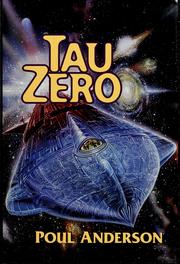Check nearby libraries
Buy this book

Poul Anderson's Tau Zero is an outstanding work of science fiction, in part because it combines two qualities that are often at odds in this genre: an interest in the emotional lives of its characters and a fascination with all things technological and scientific. In Tau Zero these components are not merely fused; they work together with a remarkable synergy that makes the novel much more than just a deep space adventure story.The novel centers on a ten-year interstellar voyage aboard the spaceship Leonora Christine, and it opens with members of the crew preparing for their departure from earth. It is an especially moving departure because they know that while they are aboard the ship and traveling close to the speed of light, time will be passing much more quickly back home. As a result, by the time they return everyone they know will have long since died. From practically the very first page, therefore, Tau Zero sets the scientific realities of space travel in dramatic tension with the no-less-real emotional and psychological states of the travelers. This is a dynamic Anderson explores with great success over the course of the novel as fifty crewmembers settle in for the long journey together. They are a highly-trained team of scientists and researchers, but they are also a community of individuals, each trying to make a life for him or herself in space.This is the background within which the action of the novel takes place. Anderson carefully depicts the network of relationships linking these people before the real plot begins to unfold. The voyage soon takes a unexpected and disastrous turn for the worse. The ship passes through a small, uncharted, cloudlike nebula that makes it impossible for the crew to decelerate the ship. The only hope, in fact, is for the ship to speed up. But acceleration towards the speed of light means that time outside the spaceship passes even more quickly, and the crew finds itself hurtling deeper into space and further into the future. Anderson's experience as a physicist is evidenced in the knowledgeable way he discusses the technical details of space and time travel, although his explanations never become burdensome or tedious. More to the point, the painstaking care with which he has drawn the characters ensures that the action is both imaginatively compelling and emotionally meaningful. It is a combination that is unfortunately all too rare in science fiction.
Check nearby libraries
Buy this book

Previews available in: English
Showing 4 featured editions. View all 24 editions?
| Edition | Availability |
|---|---|
| 1 |
eeee
Libraries near you:
WorldCat
|
| 2 |
zzzz
Libraries near you:
WorldCat
|
| 3 |
eeee
Libraries near you:
WorldCat
|
| 4 |
aaaa
Libraries near you:
WorldCat
|
Book Details
Edition Notes
"A short version of this novel appeared in Galaxy science fiction for June and August 1967 under title: To outlive eternity."
The Physical Object
ID Numbers
Community Reviews (0)
Feedback?History
- Created March 10, 2011
- 4 revisions
Wikipedia citation
×CloseCopy and paste this code into your Wikipedia page. Need help?
| August 26, 2011 | Edited by EdwardBot | merge lending editions |
| August 12, 2011 | Edited by ImportBot | add ia_box_id to scanned books |
| March 29, 2011 | Edited by WorkBot | merge works |
| March 10, 2011 | Created by ImportBot | Imported from Internet Archive item record |
















